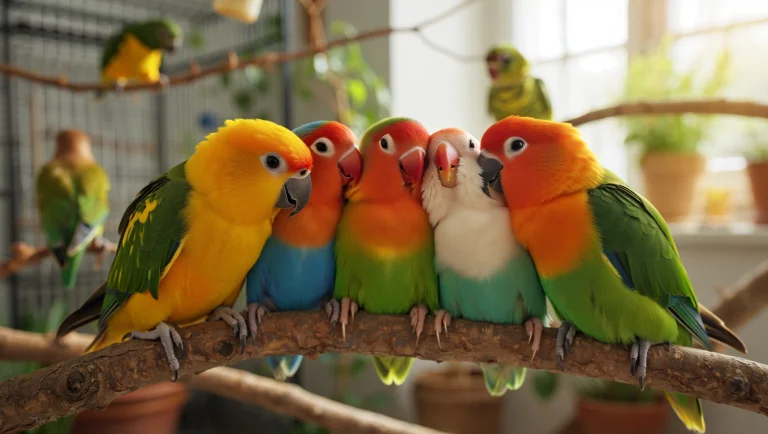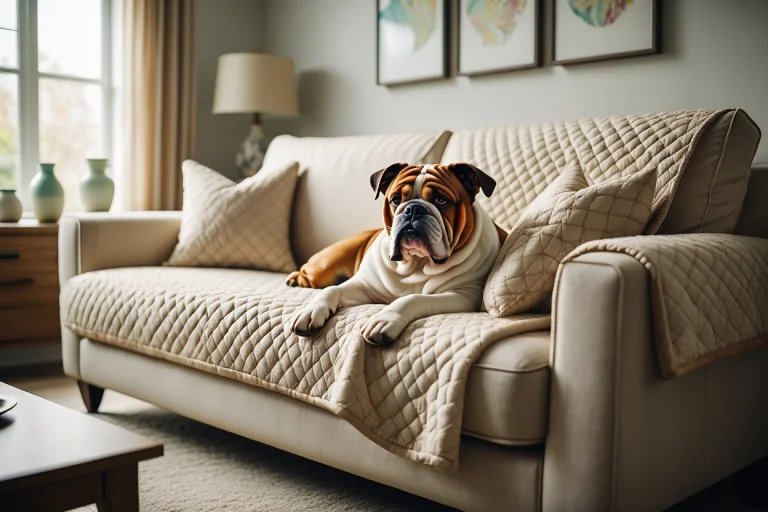Discover the top 10 cute birds for pets, ranked by appearance and personality! From playful budgies to affectionate lovebirds, find your perfect feathered companion.
Table of Contents
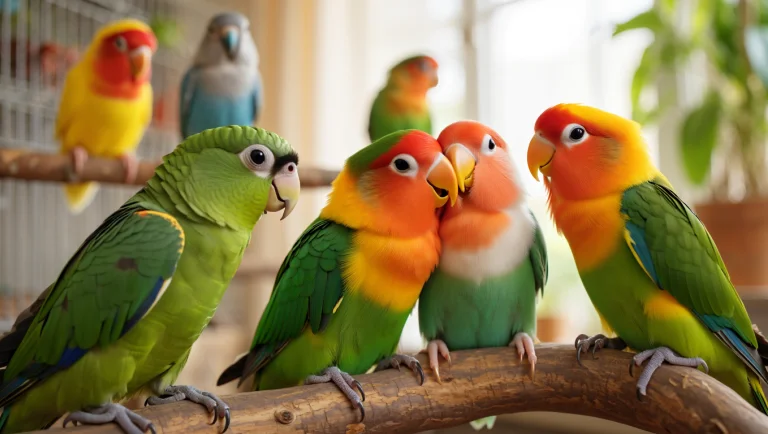
When it comes to adding a feathered friend to your family, the world of avian companions offers a delightful array of options that combine beauty, charm, and personality. Cute birds make excellent pets for those seeking companions that are visually stunning and engaging without the space requirements of larger pets. From tiny budgerigars with their chatterbox personalities to the affectionate cockatoos that form strong bonds with their owners, the avian world has something for everyone.
In this comprehensive guide, we’ll explore the most adorable avian companions ranked by both their appearance and behavior. We’ll dive into what makes each species uniquely charming, their care requirements, and how they might fit into your lifestyle. Whether you’re drawn to vibrant colors, playful antics, or melodic singing abilities, you’ll discover which cute birds might be your perfect match.
As interest in bird ownership continues to grow, understanding the distinctive traits and needs of different species becomes increasingly important. According to the American Pet Products Association’s 2023 National Pet Owners Survey, approximately 9.9 million U.S. households own birds, demonstrating their popularity as beloved companions.
Let’s explore these winged wonders that combine beauty, intelligence, and personality in compact, feathered packages.
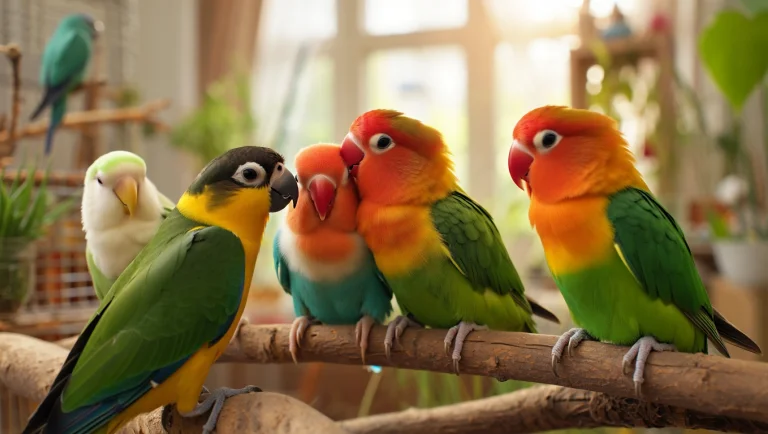
What Makes a Bird Cute?
Before diving into our rankings, it’s worth understanding what factors contribute to our perception of avian cuteness:
Physical Characteristics
- Size: Many birds considered “cute” tend to be on the smaller side, with proportionally larger heads and eyes (neotenic features that humans are biologically programmed to respond positively to).
- Coloration: Vibrant, distinctive plumage or adorable patterns often contribute to a bird’s visual appeal.
- Facial features: Round faces, expressive eyes, and distinctive markings around the face can enhance a bird’s charm.
- Proportions: Small bodies with relatively large heads and eyes tap into our innate response to “baby-like” features.
Behavioral Traits
- Playfulness: Birds that engage in playful behaviors tend to be perceived as more endearing.
- Sociability: Species that form bonds with humans and seek interaction are often considered cuter.
- Vocalizations: Sweet songs, mimicry abilities, or even the way some birds tilt their heads while listening contribute to their appeal.
- Intelligence: The ability to learn tricks, solve puzzles, or recognize their owners enhances their charm.
With these factors in mind, let’s explore the cutest bird species that combine adorable appearances with engaging personalities.
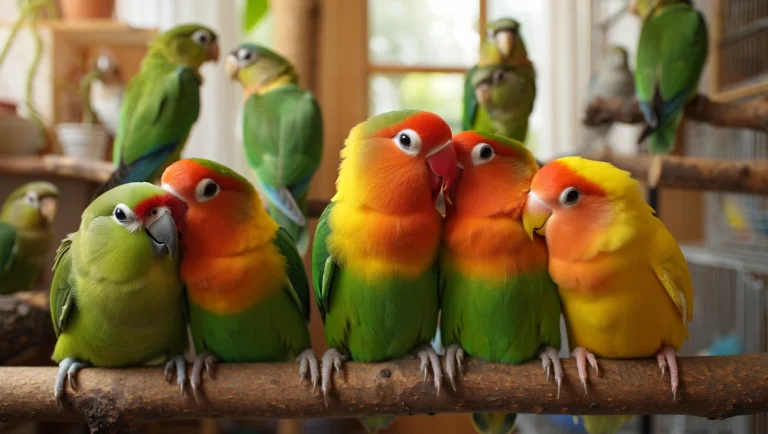
Top 10 Cutest Birds for Pet Owners
1. Budgerigars (Budgies)

Appearance: Budgerigars, commonly known as budgies or parakeets, are small parrots native to Australia. These cute birds typically measure 7-8 inches in length and come in an impressive array of colors, including blue, green, yellow, white, and various combinations. Their compact size, round faces, and expressive eyes contribute significantly to their adorable appearance.
Behavior: Budgies are renowned for their playful and social nature. They’re highly intelligent birds that can learn to speak numerous words and phrases with patient training. Their chirpy vocalizations and head-bobbing dances add to their charm, and they form strong bonds with their owners when given sufficient attention.
Care Requirements:
- Lifespan: 5-10 years
- Cage Size: Minimum 18″L x 18″W x 18″H
- Diet: High-quality seed mix, fresh vegetables, fruits, and occasional treats
- Social Needs: Daily interaction and mental stimulation; preferably kept in pairs
Why They’re Adorable: Dr. Stephanie Lamb, avian veterinarian at City Vets, notes: “Budgerigars combine the perfect package of manageable size, trainability, and sociability. Their expressive faces seem to convey emotions, and the way they interact with toys and mirrors makes them endlessly entertaining to watch.”
2. Lovebirds

Appearance: Lovebirds are small parrots measuring 5-6 inches long with relatively large heads and short, blunt tails. The most common pet species, the peach-faced lovebird, features a vibrant green body with a peachy-pink face and throat. Their compact size and round faces contribute to their undeniable cuteness.
Behavior: True to their name, lovebirds form strong bonds with their mates or human companions. They’re known for their affectionate nature, often snuggling with their partners and engaging in mutual preening. These cute birds are also quite playful and energetic, requiring plenty of mental stimulation and physical activity.
Care Requirements:
- Lifespan: 10-15 years
- Cage Size: Minimum 24″L x 24″W x 24″H
- Diet: Pellet-based diet supplemented with fresh fruits, vegetables, and occasional seeds
- Social Needs: Ideally kept in pairs; if kept singly, requires significant daily interaction
Why They’re Adorable: “Lovebirds earn their reputation for cuteness not just through their vibrant colors and compact size, but through their affectionate behaviors,” explains ornithologist Dr. Maria Chen. “The way they cuddle together and their obvious displays of affection create an immediate ‘aww’ response in most observers.”
3. Cockatiels

Appearance: Cockatiels are medium-sized parrots measuring 12-13 inches, including their long tail feathers. Their most distinctive feature is their expressive crest feathers that they can raise and lower depending on their mood. The classic cockatiel coloration includes gray body feathers, white wing patches, yellow face, and orange cheek patches, though many color mutations exist.
Behavior: Cockatiels are gentle, affectionate birds known for their melodious whistling abilities. Males particularly enjoy learning tunes and can become quite accomplished whistlers. Their crest movements provide charming visual cues to their emotional state—raised when excited or curious, flattened when relaxed or defensive.
Care Requirements:
- Lifespan: 15-25 years
- Cage Size: Minimum 24″L x 24″W x 30″H
- Diet: High-quality pellets, supplemented with fresh vegetables, some fruits, and limited seeds
- Social Needs: Daily interaction; can be kept singly if given adequate attention
Why They’re Adorable: Avian behavioral specialist Tanya Davis observes: “Cockatiels possess a unique charm—they’re just the right size to be substantial without being overwhelming. Their expressive crests and the way they’ll often sing to their human companions create an immediate connection. I’ve seen many first-time bird owners become completely smitten with their cockatiels within days of bringing them home.”
4. Finches

Appearance: Finches are tiny birds, typically 3-6 inches in length depending on the species. Zebra finches, one of the most popular pet varieties, display distinctive black and white “zebra” markings on their throats, bright orange beaks, and chestnut-colored patches on their cheeks. Society finches come in various colors including white, brown, and pied patterns.
Behavior: Unlike many pet birds, finches aren’t typically hands-on pets. Instead, they provide entertainment through their lively movements, social interactions, and pleasant chirping. They’re constantly in motion—hopping between perches, bathing enthusiastically, or engaging in charming courtship dances.
Care Requirements:
- Lifespan: 5-9 years
- Cage Size: Minimum 30″L x 18″W x 18″H (larger for multiple birds)
- Diet: High-quality finch seed mix, supplemented with fresh greens and egg food
- Social Needs: Should always be kept in pairs or small groups
Why They’re Adorable: “Finches bring a different type of cuteness to the table,” says aviculturist James Norton. “Their tiny size and constant activity create a delightful display. There’s something inherently charming about watching these small birds go about their daily routines—they’re like living art in motion.”
5. Parrotlets

Appearance: Often referred to as “pocket parrots,” parrotlets are among the smallest parrot species kept as pets, measuring just 4-5 inches in length. Pacific parrotlets, the most common pet variety, typically display vibrant green plumage with blue markings on their wings and backs. Their tiny size combined with their bold, confident stance makes them undeniably adorable.
Behavior: Don’t let their diminutive size fool you—parrotlets pack enormous personalities into their tiny frames. They’re known for their fearless attitudes, playful nature, and impressive intelligence. Many owners describe their parrotlets as “tiny macaws” due to their confident demeanor and big-bird attitudes.
Care Requirements:
- Lifespan: 15-20 years
- Cage Size: Minimum 18″L x 18″W x 18″H with narrow bar spacing
- Diet: High-quality pellets, supplemented with fresh vegetables, some fruits, and limited seeds
- Social Needs: Daily interaction and mental stimulation; can be territorial with other birds
Why They’re Adorable: “Parrotlets combine the appeal of miniature size with surprising boldness,” notes exotic pet specialist Dr. Rebecca Torres. “There’s something inherently charming about watching these tiny birds fearlessly explore their surroundings or stand their ground against much larger creatures. Their confidence-to-size ratio is simply off the charts.”
6. Canaries

Appearance: Canaries are small songbirds measuring 5-8 inches in length. While the classic yellow canary remains popular, these birds come in various colors including white, orange, red, and even green. Their sleek, clean lines and bright colors make them visually appealing additions to any home.
Behavior: Famous for their beautiful singing abilities (primarily the males), canaries bring melodious joy to their owners’ homes. Unlike many pet birds, they’re not typically handled but rather appreciated for their songs and graceful movements. They exhibit delightful behaviors like “birdbaths” in shallow water dishes and animated hopping between perches.
Care Requirements:
- Lifespan: 10-15 years
- Cage Size: Minimum 24″L x 16″W x 16″H
- Diet: High-quality canary seed mix, supplemented with fresh greens and occasional egg food
- Social Needs: Generally kept singly (especially males) to encourage singing
Why They’re Adorable: Avian expert Dr. Jonathan Lee explains: “The appeal of canaries goes beyond their bright colors. There’s something mesmerizing about watching a canary sing—they put their whole body into it, puffing out their chest, standing tall, and delivering crystal-clear notes. It’s like having a tiny, feathered opera singer in your home.”
7. Bourke’s Parakeets

Appearance: Bourke’s parakeets are medium-sized birds (7-8 inches) with a distinctive soft, pastel plumage that sets them apart from many other pet birds. Standard varieties display a beautiful blend of pink, blue, and brown tones, while rosy Bourke’s feature enhanced pink coloration. Their round bodies and gentle expressions contribute to their appealing appearance.
Behavior: Unlike many parrots, Bourke’s parakeets are known for their gentle, quiet demeanor. They’re crepuscular, meaning they’re most active during dawn and dusk, during which times they engage in delightful aerial displays and soft, pleasant warbling. Their peaceful nature makes them excellent apartment birds.
Care Requirements:
- Lifespan: 8-15 years
- Cage Size: Minimum 30″L x 18″W x 18″H
- Diet: High-quality seed mix designed for small parrots, supplemented with fresh greens and limited fruits
- Social Needs: Best kept in pairs or small groups; generally peaceful with other small birds
Why They’re Adorable: “Bourke’s parakeets possess a unique charm that comes from their softness—both in their pastel plumage and their gentle personalities,” notes aviculturist Mary Johnson. “They exhibit a kind of tranquil cuteness that’s different from the more energetic appeal of birds like budgies or lovebirds. Watching them flutter around at dawn or dusk, emitting their soft warbles, is truly a magical experience.”
8. Green-Cheeked Conures

Appearance: Green-cheeked conures are small parrots measuring 10-11 inches in length. Their striking appearance features primarily green plumage, gray chest and head, red tail feathers, and distinctive green “cheeks.” Several color mutations exist, including cinnamon, yellow-sided, and pineapple varieties. Their compact size and expressive faces contribute to their undeniable cuteness.
Behavior: These birds are known for their playful, clownish antics and affectionate nature. Green-cheeked conures love to perform acrobatic tricks, hang upside down, and engage in interactive play. They form strong bonds with their owners and often enjoy cuddling—many will nestle into their owner’s neck or shirt pocket for warmth and companionship.
Care Requirements:
- Lifespan: 15-20 years
- Cage Size: Minimum 24″L x 24″W x 30″H
- Diet: High-quality pellets, supplemented with fresh vegetables, some fruits, and limited seeds
- Social Needs: Daily interaction and mental stimulation; can be kept singly if given adequate attention
Why They’re Adorable: Avian behaviorist Dr. Michelle Park shares: “Green-cheeked conures combine the playfulness of larger parrots with a manageable size and relatively quiet nature. Their cuteness often manifests through behavior—they’ll develop specific games they like to play with their owners and have an endearing way of cocking their head to the side when curious. The way they enthusiastically greet their favorite humans is truly heart-melting.”
9. Button Quail

Appearance: Button quail are among the smallest game birds in the world, measuring just 4-6 inches in length. They feature round, plump bodies with distinctive patterned plumage in earthy tones of brown, tan, and white. Their tiny size and disproportionately small heads give them an undeniably adorable appearance.
Behavior: Unlike most pet birds, button quail are ground-dwellers that rarely fly. They scurry about with quick, darting movements that many owners find endearing. Males produce a distinctive “singing” sound that resembles a mechanical toy. Though not typically handled, they provide endless entertainment through their unique behaviors.
Care Requirements:
- Lifespan: 3-5 years
- Housing: Terrarium or specially-designed cage with solid bottom
- Diet: Game bird feed supplemented with millet, vegetables, and live insects
- Social Needs: Best kept in small groups with more females than males
Why They’re Adorable: “Button quail offer a completely different type of avian cuteness,” explains exotic pet specialist Dr. David Kim. “Their round bodies and tiny size, combined with their quick movements and the way they dust bathe, create an almost cartoonish charm. They’re like little wind-up toys—their movements are so fast and deliberate that you can’t help but smile watching them.”
10. Pacific Parrotlets

Appearance: Pacific parrotlets are among the smallest true parrots, measuring just 4.5-5 inches in length. Their most common coloration is a vibrant green with deeper blue markings on their wings and back (particularly in males). Their tiny size combined with their proportionally large eyes and head creates an immediately endearing appearance.
Behavior: Despite their diminutive size, parrotlets have outsized personalities often compared to those of much larger parrots. They’re bold, curious, and intelligent birds that enjoy interactive play and can learn to perform tricks. Many develop strong bonds with their owners and enjoy riding in pockets or perching on shoulders.
Care Requirements:
- Lifespan: 15-20 years
- Cage Size: Minimum 18″L x 18″W x 18″H with narrow bar spacing
- Diet: High-quality pellets, supplemented with fresh vegetables, some fruits, and limited seeds
- Social Needs: Daily interaction and mental stimulation; can be territorial with other birds
Why They’re Adorable: Avian specialist Dr. Sarah Williams notes: “There’s something inherently charming about creatures that don’t seem to realize their own size limitations. Pacific parrotlets approach life with the confidence and sass of much larger birds, and this ‘mighty mouse’ quality endears them to their owners. Their small size makes everything they do—from bathing in a shallow dish to emphatically shredding a toy—seem proportionally more impressive and cute.”
Factors to Consider Before Getting a Cute Bird
While these feathered friends are undeniably adorable, responsible ownership requires careful consideration of several factors:
Lifespan Commitment
Many birds have remarkably long lifespans:
- Budgies: 5-10 years
- Lovebirds: 10-15 years
- Cockatiels: 15-25 years
- Parrotlets: 15-20 years
According to the Association of Avian Veterinarians, birds are among the most frequently rehomed pets because owners underestimate the length of commitment required.
Noise Levels
Different species have varying vocalization patterns:
| Bird Species | Noise Level | Type of Sound |
| Budgerigar | Moderate | Chattering, possible speech |
| Cockatiel | Moderate | Whistling, occasional screaming |
| Lovebird | Moderate-High | Sharp chirps, chatter |
| Finch | Low | Quiet chirping |
| Canary | Low-Moderate | Melodious singing (males) |
| Parrotlet | Low-Moderate | Chirps, chatter |
| Conure | High | Calls, screaming |
| Button Quail | Very Low | Quiet trills |
Space Requirements
Birds need adequate cage space and, ideally, safe out-of-cage time:
- Minimum cage size: Generally, the bird should be able to fully extend its wings in all directions
- Proper bar spacing: Smaller birds require narrower spacing to prevent escape
- Quality over quantity: A single spacious cage is better than multiple cramped ones
Time Commitment
According to avian behavior consultant Stephanie Edlund: “Birds are not ‘set it and forget it’ pets. Most pet birds evolved as flock animals and have strong social needs. Even relatively independent species like canaries require daily care and attention.”
Daily tasks include:
- Feeding and water changes
- Cage cleaning
- Social interaction
- Mental stimulation
- Monitoring health
Financial Considerations
The American Veterinary Medical Association estimates the following annual costs for bird ownership:
- Initial setup: $200-500 (cage, accessories, initial vet visit)
- Annual food costs: $100-300 depending on species
- Veterinary care: $100-200 for routine checkups
- Emergency care: Can exceed $500 for serious issues
Local Regulations
Before bringing home a feathered friend, check:
- Apartment or HOA restrictions
- Local ordinances regarding exotic pets
- Noise regulations in your area
Tips for Enhancing Your Bird’s Cuteness Factor
Photography Opportunities
Capturing your bird’s adorable moments:
- Use natural lighting when possible
- Get down to your bird’s level
- Use burst mode to capture quick movements
- Consider investing in a macro lens for close-up detail shots
Creating Cute Environments
Enhance your bird’s habitat aesthetically:
- Choose colorful, safe toys that complement your bird’s coloration
- Consider natural wood perches and swings
- Create foraging opportunities that showcase natural behaviors
- Design a play area outside the cage for supervised playtime
Training for Adorable Behaviors
Many birds can learn behaviors that enhance their charm:
- Target training (following a stick with their beak)
- Simple tricks like turning around or waving
- Step-up training for hand taming
- For more vocal species, teaching simple words or melodies
Dr. Irene Pepperberg, renowned for her work with Alex the African Grey Parrot, notes: “When birds learn to interact with humans through training, it creates a special bond. Even simple behaviors like coming when called or stepping onto a hand can create meaningful connections.”
Health and Wellness for Cute Birds
Maintaining your bird’s health is essential for preserving both its adorable appearance and engaging behaviors:
Nutrition Essentials
- Species-appropriate diet: Research specific nutritional needs
- Fresh foods: Offer a variety of vegetables and limited fruits
- Pellet conversion: Many avian veterinarians recommend pellet-based diets supplemented with fresh foods
- Clean water: Always provide fresh, clean water daily
Environmental Needs
- Temperature: Maintain a consistent 65-80°F (18-27°C)
- Humidity: Most birds prefer 50-70% humidity
- Lighting: Provide access to natural light or full-spectrum lighting
- Air quality: Avoid exposure to fumes, smoke, or aerosols
Behavioral Enrichment
- Rotation of toys: Provide variety and regularly introduce new items
- Foraging opportunities: Hide treats in toys to encourage natural behaviors
- Social interaction: Spend quality time with your bird daily
- Mental stimulation: Teach new tricks or words
Recognizing Signs of Illness
According to avian veterinarian Dr. Laurie Hess: “Birds are masters at hiding illness. By the time symptoms are obvious, the condition may be advanced. Regular weighing is one of the best ways to catch problems early.”
Watch for these warning signs:
- Changes in droppings
- Decreased appetite
- Fluffed feathers during the day
- Changes in vocalization
- Weight loss
- Discharge from eyes or nostrils
CTA Before Conclusion
For more expert pet care tips and product recommendations, visit blithepet.com — your trusted source for pet wellness.
Conclusion
The world of cute birds offers something for nearly every potential pet owner—from the tiny, low-maintenance finch to the interactive, affectionate cockatiel. By understanding both the visual appeal and behavioral characteristics of different species, you can find a feathered companion that brings joy to your home for years to come.
Remember that responsible bird ownership extends beyond appreciating their cuteness. These intelligent creatures require appropriate housing, nutrition, socialization, and veterinary care to thrive. When properly cared for, the cute birds featured in this guide reward their owners with charming behaviors, beautiful colors, and meaningful companionship.
Whether you’ve fallen for the playful antics of a budgie, the sweet songs of a canary, or the affectionate nature of a lovebird, bringing a bird into your life opens the door to a unique and rewarding relationship. Their distinctive personalities and engaging behaviors ensure that no two days with your feathered friend will be quite the same.
Have a similar experience with your pet bird? Share it in the comments below!
FAQ Section
What is the friendliest type of pet bird?
Budgerigars (budgies) and cockatiels are widely considered among the friendliest pet birds for beginners. Both species are relatively easy to tame, form strong bonds with their owners, and can become quite affectionate with proper socialization. Budgies are more energetic and playful, while cockatiels tend to be more gentle and cuddly.
Do cute birds make good pets for children?
Some bird species can make suitable pets for families with children, but adult supervision is always necessary. Larger birds like cockatiels are generally better choices than very small, delicate species like finches. Children should be taught proper handling techniques, and the family should understand that birds require consistent care regardless of changing interests.
How much does it cost to own a pet bird?
Initial costs for a small bird like a budgie or finch typically range from $200-500, including the bird, cage, accessories, and initial veterinary checkup. Annual costs can range from $150-500 depending on the species, covering food, toys, and routine healthcare. Larger or rarer species generally have higher costs both initially and throughout their lives.
Do cute birds need a lot of attention?
The social needs of birds vary by species. Highly social birds like budgies, lovebirds, and cockatiels need daily interaction and can become depressed without adequate attention. Species like finches and canaries are less dependent on human interaction but still benefit from environmental enrichment and observation of their natural behaviors.
What’s the best cute bird for apartment living?
For apartments, consider birds with moderate to low noise levels and smaller space requirements. Bourke’s parakeets, Pacific parrotlets, and society finches are excellent choices. These species produce relatively quiet vocalizations that are less likely to disturb neighbors while still providing the companionship and entertainment value of pet birds.
How long do pet birds live?
Lifespans vary significantly by species: finches and budgies typically live 5-10 years, cockatiels 15-25 years, and some parrot species 20+ years. Proper nutrition, housing, and veterinary care all contribute to maximizing your bird’s lifespan. Potential bird owners should carefully consider whether they can commit to the full lifespan of their chosen species.

